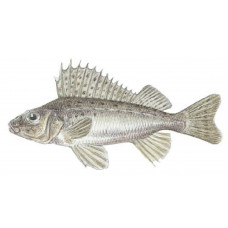Latin name
Gymnocephalus cernuus
Other names
Eurasian ruffe; French: grémille; German: kaulbarsch; Polish: jazgarz; Russian: yersh obyknovennyi.
Identification
The ruffe is very similar to the yellow perch in body shape and to the walleye in body coloration. It has a spiny first dorsal fin connected to a second soft dorsal fin, two deep sharp spines on the anal fin, one sharp spine on the pelvic fins, and sharp spines on the gill cover. The dorsal fins have rows of dark spots, the eyes are large and glassy, and the mouth is small and drooping. There are no scales on the head.
Distribution
Ruffe has become a significant threat to the delicate predator-prey balance needed to sustain thriving fisheries in North American waters, especially the Great Lakes. It has only been reported in the waters of Lake Superior, but is likely to exist elsewhere. The species found and breeding in Lake Superior has been identified as Gymnocephalus cernuus. The native range of G. cernuus extends from France to the Kolyma River in eastern Siberia, and it has been introduced into England, Scotland, and Scandinavia.
Habitat
Ruffe are found in freshwater and brackish waters with salinities ranging from 3 to 5 parts per million. It lives in a variety of lake environments, preferring muddy areas and soft bottoms without vegetation. In rivers, it prefers slow-moving water and is more tolerant of turbid and eutrophic conditions than many other perch.
Size
The ruffe rarely exceeds 6 inches in length, but can reach 10 inches. Most female ruffe live 7 years, but can live as long as 11 years. Males typically live 3 to 5 years.
Life history and Behavior
Ruffe mature at 2-3 years of age and spawn between mid-April and July, depending on location, temperature and habitat. Juvenile ruffe grow faster than many of their competitors, and adults breed prolifically, ensuring rapid population growth. It is a nocturnal fish that spends its days in deep water and moves to shallower waters at night to feed.
Food and feeding habits
The main diet of ruffe is small aquatic insects and larvae, but they may also consume fish roe.
Reproduction
No information
| Classification | |
| Phylum | Chordata |
| Class | Actinopterygii |
| Squad | Perciformes |
| Family | Percidae |
| Genus | Gymnocephalus |
| Species | G. cernua |
| Features | |
| Conservation status | Least Concern |
| Habitat | Pelagic |
| Life span, years | 11 |
| Maximum body weight, kg | No information |
| Maximum length, cm | 29 |
| Sailing speed, m/s | No information |
| Threat to people | No information |
| Way of eating | Bentophage |
Ruffe
Tags: Ruffe




